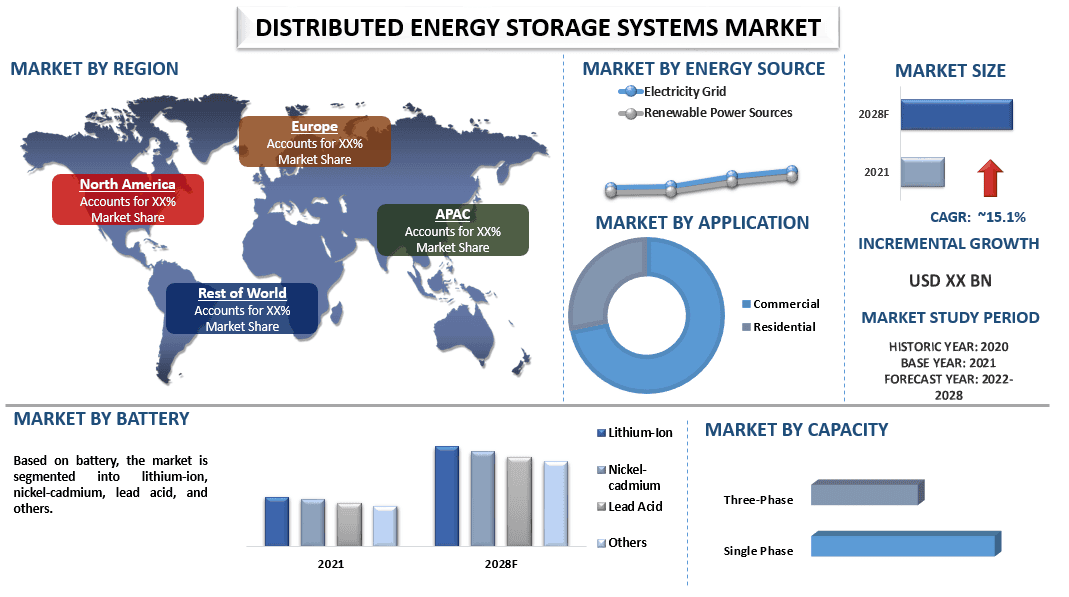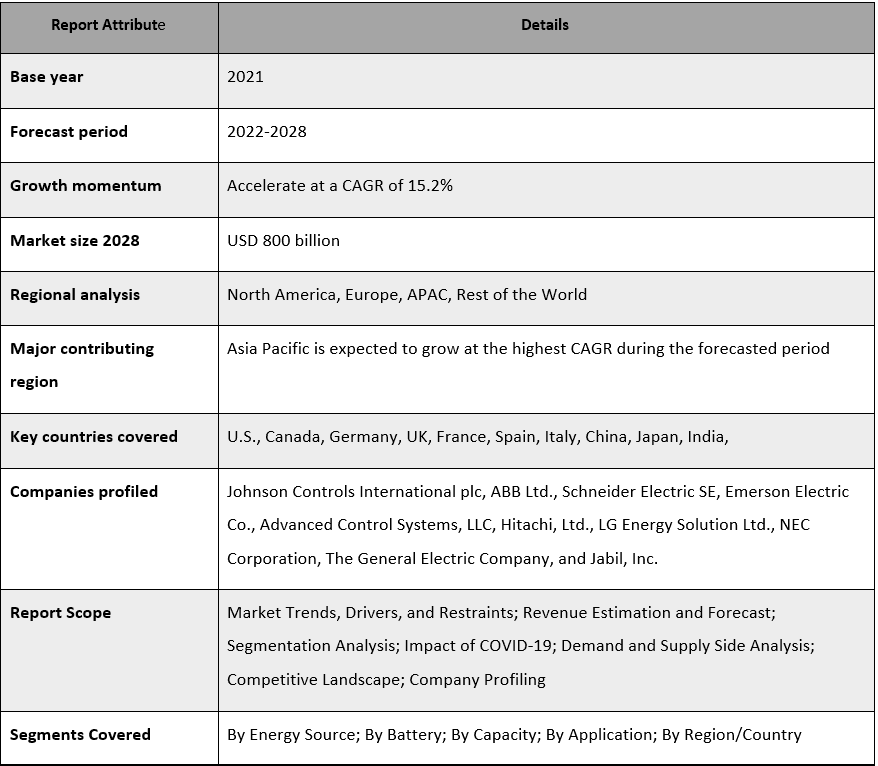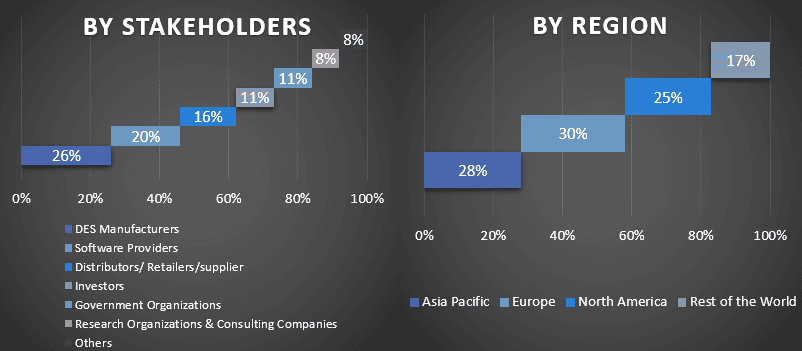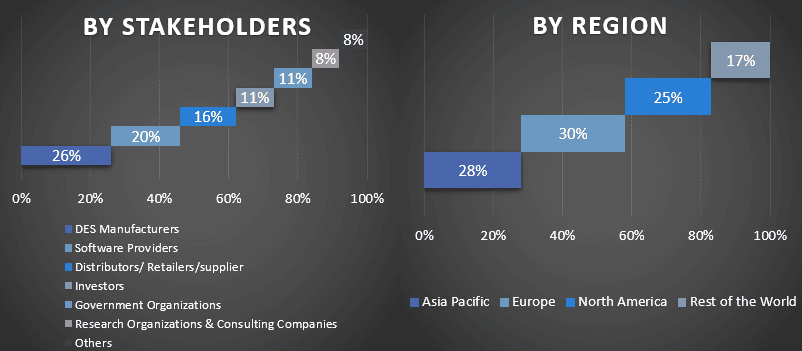Emphasis on Energy Source (Electricity Grid, Renewable Power Sources); Battery (Lithium-Ion, Nickel-cadmium, Lead Acid, Others); Capacity (Single Phase, Three-Phase); Application (Commercial, Residential); and Region/Country

Distributed energy storage systems market was valued at USD 800 billion in 2028 & is expected to grow at a CAGR of 15.1 % from 2022-2028. Factors such as the increasing deployment of renewable resources such as solar and wind are rapidly growing coupled with new and innovative approaches towards the management of electricity is accelerating the market size of distributed energy storage systems market. In addition, distributed energy storage systems play a vital role in various applications and use the flexibility of backup power batteries to control the electricity supply in thousands of base stations in the mobile network throughout the day. The DES system optimizes the timing of electricity purchases by scheduling charging and discharging periods for the batteries. Therefore, growing energy resilience demand across the globe would accentuate the market size of distributed energy storage (DES) systems.
Some of the major players operating in the market include Siemens, ABB, Honeywell International, Robert Bosch GmbH, TE Connectivity Ltd, BD Sensors GmbH, Emerson Electric Co., General Electric, Parker Hannifin Corp (Lord), Fortive.
Several M&As along with partnerships have been undertaken by these players to facilitate customers with hi-tech and innovative products/technologies.
Insights Presented in the Report
“Amongst energy sources, the electricity grid segment held a dominating share of the market in 2021”
Based on the energy source, the market is bifurcated into the electricity grid, and renewable power sources. Amongst these, the electricity grid segment catered to a significant share of the market. Energy storage technologies are a key enabler of grid modernization, addressing the electric grid’s needs by improving its stability and resiliency. In addition, the growing demand for electricity across the globe is escalating the need to invest in cost-effective distributed energy storage systems to improve flexibility in the electricity grid and respond to fluctuating and escalating electricity demands, ensuring that electricity is available when and where it is needed.
“Amongst applications, the commercial segment held the majority share of the market in 2021”
On the basis of application, the market is classified into commercial and residential. The commercial application held a major share of the distributed energy storage (DES) systems market in 2020 and is expected to grow at a substantial CAGR during the forecasted period. Commercial buildings require an energy storage system that helps level out peaks in electricity use, shift loads and provide emergency backups and frequency regulation to ensure grid stability and power quality. Therefore, the growing adoption of variable renewable energy sources such as solar and wind for large-scale industries integrated with distributed energy storage systems is propelling its market demand.
“Asia Pacific dominated the Distributed Energy Storage (DES) System market in 2021”
Asia Pacific dominated the distributed energy storage (DES) systems market in 2021. It is predominantly attributed due to the increasing demand and consumption of electricity in countries such as China, India, Japan, and so on, coupled with the massive surge in investments in renewable energy in the region. For instance, by 2030, Asia Pacific investments in renewable energy production are estimated to be more than double to nearly USD 1.5 trillion. Moreover, increasing development and investment in clean energy sources, along with the rapid urbanization and growing population ratio is also expected to boost the market growth during the forecast period.
Distributed Energy Storage (DES) System Market Report Coverage

Reasons to buy this report:
Customization Options:
The global Distributed Energy Storage (DES) System market can further be customized as per the requirement or any other market segment. Besides this, UMI understands that you may have your own business needs, hence feel free to connect with us to get a report that completely suits your requirements.
1. Market Introduction
2. Research Methodology Or Assumption
3. Market Synopsis
4. Executive Summary
5. Global Distributed Energy Storage Systems Market Covid-19 Impact
6. Global Distributed Energy Storage Systems Market Revenue, 2020-2028f
7. Market Insights By Energy Source
8. Market Insights By Battery
9. Market Insights By Capacity
10. Market Insights By Application
11. Market Insights By Region
12. Distributed Energy Storage Systems Market Dynamics
13. Distributed Energy Storage Systems Market Opportunities
14. Distributed Energy Storage Systems Market Trends
15. Demand And Supply-side Analysis
16. Value Chain Analysis
17. Strategic Insights
18. Competitive Scenario
19. Company Profiled
20. Disclaimer
Research Methodology for the Distributed Energy Storage (DES) System Market Analysis (2022-2028)
Analyzing the historical market, estimating the current market, and forecasting the future market of the global distributed energy storage system market were the three major steps undertaken to create and analyze the adoption of distributed energy storage systems in major regions globally. Exhaustive secondary research was conducted to collect the historical market numbers and estimate the current market size. Secondly, to validate these insights, numerous findings and assumptions were taken into consideration. Moreover, exhaustive primary interviews were also conducted, with industry experts across the value chain of the global distributed energy storage (des) system market. Post assumption and validation of market numbers through primary interviews, we employed a top-down/bottom-up approach to forecasting the complete market size. Thereafter, market breakdown and data triangulation methods were adopted to estimate and analyze the market size of segments and sub-segments of the industry pertains to. Detailed methodology is explained below:
Analysis of Historical Market Size
Step 1: In-Depth Study of Secondary Sources:
Detail secondary study was conducted to obtain the historical market size of the distributed energy storage (des) system market through company internal sources such as annual reports & financial statements, performance presentations, press releases, etc., and external sources including journals, news & articles, government publications, competitor publications, sector reports, third-party database, and other credible publications.
Step 2: Market Segmentation:
After obtaining the historical market size of the distributed energy storage (des) system market, we conducted a detailed secondary analysis to gather historical market insights and share for different segments & sub-segments for major regions. Major segments are included in the report as an energy source, battery, capacity, and application. Further country-level analyses were conducted to evaluate the overall adoption of testing models in that region.
Step 3: Factor Analysis:
After acquiring the historical market size of different segments and sub-segments, we conducted a detailed factor analysis to estimate the current market size of the distributed energy storage (des) system market. Further, we conducted factor analysis using dependent and independent variables such as sensor type, connectivity, and application of the distributed energy storage (des) system market. A thorough analysis was conducted for demand and supply-side scenarios considering top partnerships, mergers and acquisitions, business expansion, and product launches in the Distributed Energy Storage (DES) System market sector across the globe.
Current Market Size Estimate & Forecast
Current Market Sizing: Based on actionable insights from the above 3 steps, we arrived at the current market size, key players in the global distributed energy storage (des) system market, and market shares of the segments. All the required percentage shares split, and market breakdowns were determined using the above-mentioned secondary approach and were verified through primary interviews.
Estimation & Forecasting: For market estimation and forecast, weights were assigned to different factors including drivers & trends, restraints, and opportunities available for the stakeholders. After analyzing these factors, relevant forecasting techniques i.e., the top-down/bottom-up approach were applied to arrive at the market forecast for 2028 for different segments and sub-segments across the major markets globally. The research methodology adopted to estimate the market size encompasses:
Market Size and Share Validation
Primary Research: In-depth interviews were conducted with the Key Opinion Leaders (KOLs) including Top Level Executives (CXO/VPs, Sales Head, Marketing Head, Operational Head, Regional Head, Country Head, etc.) across major regions. Primary research findings were then summarized, and statistical analysis was performed to prove the stated hypothesis. Inputs from primary research were consolidated with secondary findings, hence turning information into actionable insights.
Split of Primary Participants in Different Regions

Market Engineering
The data triangulation technique was employed to complete the overall market estimation and to arrive at precise statistical numbers for each segment and sub-segment of the global distributed energy storage (des) system market. data was split into several segments & sub-segments post studying various parameters and trends in the areas of the sensor type, connectivity, and application in the global distributed energy storage (des) system market.
The main Objective of the Global Distributed Energy Storage (DES) System Market Study
The current & future market trends of the globally distributed energy storage (des) system market were pinpointed in the study. Investors can gain strategic insights to base their discretion for investments on the qualitative and quantitative analysis performed in the study. Current and future market trends determined the overall attractiveness of the market at a regional level, providing a platform for the industrial participant to exploit the untapped market to benefit from a first-mover advantage. Other quantitative goals of the studies include:

Customers who bought this item also bought